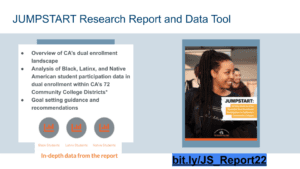Dual enrollment participation is increasing statewide, but there are still equity gaps. CLP’s dual enrollment capacity-building webinar, Using Data to Inform Equity, reviewed a recent report from the Public Policy Institute of California (PPIC), showed publicly available data tools, and featured the work of Los Angeles Valley College to design its Men of Color High Achievers program.
(Register for the next two webinars: Designing Pathways with Community Partners on Nov 7 and Embedded Student Supports on Dec 5.)
Diane Crum, Education Programs Consultant in the High School Innovations and Initiatives Office of the California Department of Education, opened the webinar with a welcome for participants and a shout-out to the high school/college partnerships that won California Exemplary Dual Enrollment Awards and the work they’ve done to provide equitable access.
CLP Director Laurencia Walker highlighted recent findings from the PPIC report, Improving College Access and Success through Dual Enrollment. The study found that the number of California students participating in dual enrollment has grown steadily since 2015-16, with much of the growth driven by College and Career Access Pathways (CCAP) dual enrollment.
CCAP is intended to expand access for students underserved in postsecondary education, and the study found promising signs that it is working. Some of these findings: Overall and by race/ethnicity, CCAP students are doing better than non-dual enrollees; and participation in CCAP is also relatively equitable compared with other forms of dual enrollment. Yet the report emphasized that there are further opportunities for growth and improvement, especially to support Black students and male students.
Los Angeles Valley College is designing its Men of Color High Achievers (MOCHA) program for equity and success. MOCHA, which will launch in spring 2024, is a high-touch, high-engagement student support program focused on men of color who might not see college as a readily accessible option. Brandon Hildreth, Academic Dean of Adult Education, Workforce Development and Dual Enrollment at LA Valley College, explained how his team worked with their dual enrollment partner, Los Angeles Unified School District, to identify high schools with large populations of Black and Latino men in 11th grade who might benefit from additional support in preparing for and accessing college classes.
The design of the MOCHA program uses a number of key approaches identified in the PPIC study–intentional recruitment, focused support for the gateway courses of transfer-level English and math, and connection to student supports. In doing so, they’re building on existing efforts at the college including dual enrollment, guided pathways, and the first-year experience program.
For partnerships that are working to make dual enrollment participation more equitable, publicly available data tools are a good place to begin. Naomi Castro, Chief Program Officer at CLP, gave a walkthrough of Data Mart, the public website for community college data, and DataQuest for K-12 data. She explained some of the pitfalls in interpreting data and definitions between the K-12 and postsecondary systems. And she also gave examples of custom data dashboards developed by the Fresno K-16 Collaborative and El Camino College.
Camille Medrano, Senior Educator Engagement Associate at the Education Trust-West, provided a demo of EdTrust-West’s Jumpstart, a web-based tool that provides a snapshot of dual enrollment by community college district, and includes three equity metrics: a participation score, an equity rating, and a representation goal. Although the tool is based on 2019-20 school year data, reviewing the metrics can give your partnership a place to start before looking at your own data to formulate goals.
Access the webinar recording and slides.
Register for the next two webinars:
- Designing Pathways with Community Partners, Tuesday, November 7, 10 a.m. – 11 a.m.
Explore how we can design pathways that span high school and college, that are both college and career. Hear examples from practitioners of engaging with employers and community-based organizations to better support students. - Embedded Student Supports, Tuesday, December 5, 10 a.m. – 11 a.m.
High expectations coupled with high supports are markers of quality dual enrollment. Join us to hear practitioners share how they embed supports for students in both their programs and the classes themselves for more equitable student success.
CLP’s support for state dual enrollment grantees is funded by the Californians Dedicated to Education Foundation, which partners with the CDE and supports its mission to provide a world-class education for all students, from early childhood to adulthood.